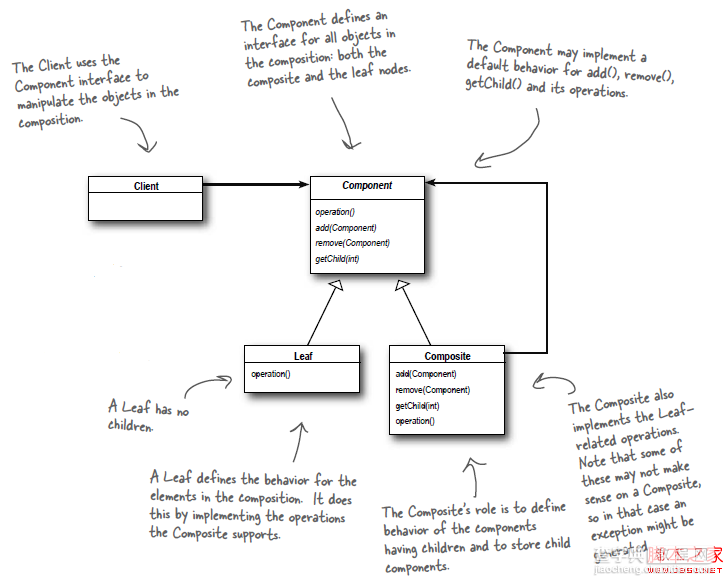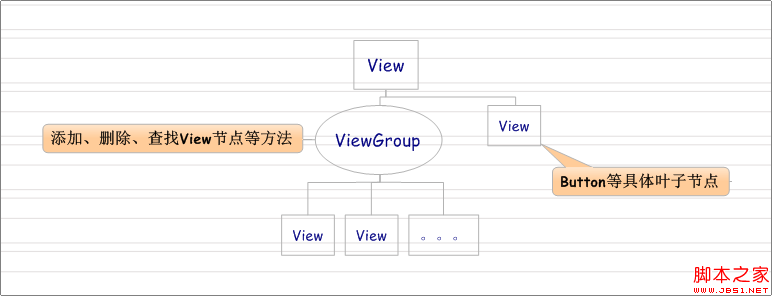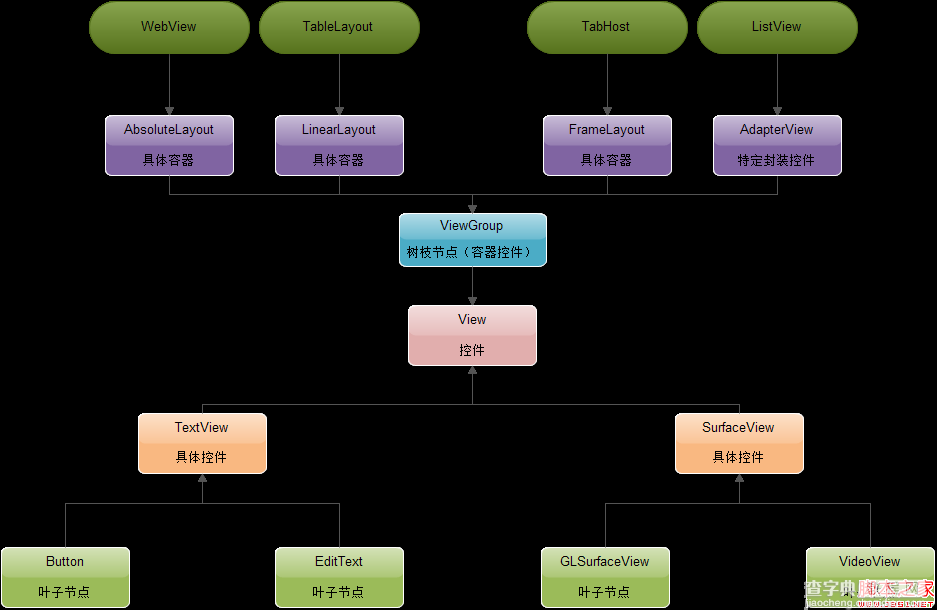组合模式定义:
Compose objects into tree structures to represent part-whole hierarchies. Composite lets clients treat individual objects and compositions of objects uniformly.
将对象组合成树形结构以表示“部分-整体”的层次结构,使得用户对单个对象和组合对象的使用具有一致性。

如上图所示(截取自《Head First Design Patterns》一书),主要包括三个部分:
1. Component抽象组件。定义参加组合对象的共有方法和属性,可以定义一些默认的函数或属性。
2. Leaf叶子节点。构成组合树的最小构建单元。
3. Composite树枝节点组件。它的作用是组合树枝节点和叶子节点形成一个树形结构。
高层模块调用简单。一棵树形结构的所有节点都是Component,局部和整体对调用者来说都是一样的,没有区别,所以高层模块不比关心自己处理的是单个对象还是整个组合结构,简化了高层模块的代码。
节点自由扩展增加。使用组合模式,如果想增加一个树枝节点或者叶子节点都是很简单的,只要找到它的父节点就可以了,非常容易扩展,符合“开闭原则”。
应用最广的模式之一。应用在维护和展示部分-整体关系的场景,如树形菜单、文件夹管理等等。
在Android源码中,都能找到使用组合模式的例子,其中在《Android源码学习之观察者模式应用》介绍到的ViewGroup和View的结构就是一个组合模式,结构图如下所示:

现在来看看它们是如何利用组合模式组织在一起的,首先在View类定义了有关具体操作,然后在ViewGroup类中继承View类,并添加相关的增加、删除和查找孩子View节点,代码如下:
复制代码 代码如下:
* @attr ref android.R.styleable#ViewGroup_clipChildren
* @attr ref android.R.styleable#ViewGroup_clipToPadding
* @attr ref android.R.styleable#ViewGroup_layoutAnimation
* @attr ref android.R.styleable#ViewGroup_animationCache
* @attr ref android.R.styleable#ViewGroup_persistentDrawingCache
* @attr ref android.R.styleable#ViewGroup_alwaysDrawnWithCache
* @attr ref android.R.styleable#ViewGroup_addStatesFromChildren
* @attr ref android.R.styleable#ViewGroup_descendantFocusability
* @attr ref android.R.styleable#ViewGroup_animateLayoutChanges
*/
public abstract class ViewGroup extends View implements ViewParent, ViewManager {
接着看增加孩子节点函数:
复制代码 代码如下:
/**
* Adds a child view. If no layout parameters are already set on the child, the
* default parameters for this ViewGroup are set on the child.
*
* @param child the child view to add
*
* @see #generateDefaultLayoutParams()
*/
public void addView(View child) {
addView(child, -1);
}
/**
* Adds a child view. If no layout parameters are already set on the child, the
* default parameters for this ViewGroup are set on the child.
*
* @param child the child view to add
* @param index the position at which to add the child
*
* @see #generateDefaultLayoutParams()
*/
public void addView(View child, int index) {
LayoutParams params = child.getLayoutParams();
if (params == null) {
params = generateDefaultLayoutParams();
if (params == null) {
throw new IllegalArgumentException("generateDefaultLayoutParams() cannot return null");
}
}
addView(child, index, params);
}
/**
* Adds a child view with this ViewGroup's default layout parameters and the
* specified width and height.
*
* @param child the child view to add
*/
public void addView(View child, int width, int height) {
final LayoutParams params = generateDefaultLayoutParams();
params.width = width;
params.height = height;
addView(child, -1, params);
}
/**
* Adds a child view with the specified layout parameters.
*
* @param child the child view to add
* @param params the layout parameters to set on the child
*/
public void addView(View child, LayoutParams params) {
addView(child, -1, params);
}
/**
* Adds a child view with the specified layout parameters.
*
* @param child the child view to add
* @param index the position at which to add the child
* @param params the layout parameters to set on the child
*/
public void addView(View child, int index, LayoutParams params) {
if (DBG) {
System.out.println(this + " addView");
}
// addViewInner() will call child.requestLayout() when setting the new LayoutParams
// therefore, we call requestLayout() on ourselves before, so that the child's request
// will be blocked at our level
requestLayout();
invalidate(true);
addViewInner(child, index, params, false);
}
在ViewGroup中我们找到了添加addView()方法,有了增加孩子节点,肯定有相对应删除孩子节点的方法,接着看:
复制代码 代码如下:
public void removeView(View view) {
removeViewInternal(view);
requestLayout();
invalidate(true);
}
/**
* Removes a view during layout. This is useful if in your onLayout() method,
* you need to remove more views.
*
* @param view the view to remove from the group
*/
public void removeViewInLayout(View view) {
removeViewInternal(view);
}
/**
* Removes a range of views during layout. This is useful if in your onLayout() method,
* you need to remove more views.
*
* @param start the index of the first view to remove from the group
* @param count the number of views to remove from the group
*/
public void removeViewsInLayout(int start, int count) {
removeViewsInternal(start, count);
}
/**
* Removes the view at the specified position in the group.
*
* @param index the position in the group of the view to remove
*/
public void removeViewAt(int index) {
removeViewInternal(index, getChildAt(index));
requestLayout();
invalidate(true);
}
/**
* Removes the specified range of views from the group.
*
* @param start the first position in the group of the range of views to remove
* @param count the number of views to remove
*/
public void removeViews(int start, int count) {
removeViewsInternal(start, count);
requestLayout();
invalidate(true);
}
private void removeViewInternal(View view) {
final int index = indexOfChild(view);
if (index >= 0) {
removeViewInternal(index, view);
}
}
private void removeViewInternal(int index, View view) {
if (mTransition != null) {
mTransition.removeChild(this, view);
}
boolean clearChildFocus = false;
if (view == mFocused) {
view.clearFocusForRemoval();
clearChildFocus = true;
}
if (view.getAnimation() != null ||
(mTransitioningViews != null && mTransitioningViews.contains(view))) {
addDisappearingView(view);
} else if (view.mAttachInfo != null) {
view.dispatchDetachedFromWindow();
}
onViewRemoved(view);
needGlobalAttributesUpdate(false);
removeFromArray(index);
if (clearChildFocus) {
clearChildFocus(view);
}
}
/**
* Sets the LayoutTransition object for this ViewGroup. If the LayoutTransition object is
* not null, changes in layout which occur because of children being added to or removed from
* the ViewGroup will be animated according to the animations defined in that LayoutTransition
* object. By default, the transition object is null (so layout changes are not animated).
*
* @param transition The LayoutTransition object that will animated changes in layout. A value
* of <code>null</code> means no transition will run on layout changes.
* @attr ref android.R.styleable#ViewGroup_animateLayoutChanges
*/
public void setLayoutTransition(LayoutTransition transition) {
if (mTransition != null) {
mTransition.removeTransitionListener(mLayoutTransitionListener);
}
mTransition = transition;
if (mTransition != null) {
mTransition.addTransitionListener(mLayoutTransitionListener);
}
}
/**
* Gets the LayoutTransition object for this ViewGroup. If the LayoutTransition object is
* not null, changes in layout which occur because of children being added to or removed from
* the ViewGroup will be animated according to the animations defined in that LayoutTransition
* object. By default, the transition object is null (so layout changes are not animated).
*
* @return LayoutTranstion The LayoutTransition object that will animated changes in layout.
* A value of <code>null</code> means no transition will run on layout changes.
*/
public LayoutTransition getLayoutTransition() {
return mTransition;
}
private void removeViewsInternal(int start, int count) {
final View focused = mFocused;
final boolean detach = mAttachInfo != null;
View clearChildFocus = null;
final View[] children = mChildren;
final int end = start + count;
for (int i = start; i < end; i++) {
final View view = children[i];
if (mTransition != null) {
mTransition.removeChild(this, view);
}
if (view == focused) {
view.clearFocusForRemoval();
clearChildFocus = view;
}
if (view.getAnimation() != null ||
(mTransitioningViews != null && mTransitioningViews.contains(view))) {
addDisappearingView(view);
} else if (detach) {
view.dispatchDetachedFromWindow();
}
needGlobalAttributesUpdate(false);
onViewRemoved(view);
}
removeFromArray(start, count);
if (clearChildFocus != null) {
clearChildFocus(clearChildFocus);
}
}
/**
* Call this method to remove all child views from the
* ViewGroup.
*/
public void removeAllViews() {
removeAllViewsInLayout();
requestLayout();
invalidate(true);
}
/**
* Called by a ViewGroup subclass to remove child views from itself,
* when it must first know its size on screen before it can calculate how many
* child views it will render. An example is a Gallery or a ListView, which
* may "have" 50 children, but actually only render the number of children
* that can currently fit inside the object on screen. Do not call
* this method unless you are extending ViewGroup and understand the
* view measuring and layout pipeline.
*/
public void removeAllViewsInLayout() {
final int count = mChildrenCount;
if (count <= 0) {
return;
}
final View[] children = mChildren;
mChildrenCount = 0;
final View focused = mFocused;
final boolean detach = mAttachInfo != null;
View clearChildFocus = null;
needGlobalAttributesUpdate(false);
for (int i = count - 1; i >= 0; i--) {
final View view = children[i];
if (mTransition != null) {
mTransition.removeChild(this, view);
}
if (view == focused) {
view.clearFocusForRemoval();
clearChildFocus = view;
}
if (view.getAnimation() != null ||
(mTransitioningViews != null && mTransitioningViews.contains(view))) {
addDisappearingView(view);
} else if (detach) {
view.dispatchDetachedFromWindow();
}
onViewRemoved(view);
view.mParent = null;
children[i] = null;
}
if (clearChildFocus != null) {
clearChildFocus(clearChildFocus);
}
}
/**
* Finishes the removal of a detached view. This method will dispatch the detached from
* window event and notify the hierarchy change listener.
*
* @param child the child to be definitely removed from the view hierarchy
* @param animate if true and the view has an animation, the view is placed in the
* disappearing views list, otherwise, it is detached from the window
*
* @see #attachViewToParent(View, int, android.view.ViewGroup.LayoutParams)
* @see #detachAllViewsFromParent()
* @see #detachViewFromParent(View)
* @see #detachViewFromParent(int)
*/
protected void removeDetachedView(View child, boolean animate) {
if (mTransition != null) {
mTransition.removeChild(this, child);
}
if (child == mFocused) {
child.clearFocus();
}
if ((animate && child.getAnimation() != null) ||
(mTransitioningViews != null && mTransitioningViews.contains(child))) {
addDisappearingView(child);
} else if (child.mAttachInfo != null) {
child.dispatchDetachedFromWindow();
}
onViewRemoved(child);
}
同样的,也有查找获得孩子节点的函数:
复制代码 代码如下:
/**
* Returns the view at the specified position in the group.
*
* @param index the position at which to get the view from
* @return the view at the specified position or null if the position
* does not exist within the group
*/
public View getChildAt(int index) {
if (index < 0 || index >= mChildrenCount) {
return null;
}
return mChildren[index];
}
注:其中具体叶子节点,如Button,它是继承TextView的,TextView是继承View的,代码如下:
复制代码 代码如下:
public class TextView extends View implements ViewTreeObserver.OnPreDrawListener {
。。。
}
注:其中使用(继承)到ViewGroup类的有我们常用的容器类(包装和容纳各种View),如LinearLayout、FrameLayout等,代码如下:
复制代码 代码如下:
public class LinearLayout extends ViewGroup {
public static final int HORIZONTAL = 0;
public static final int VERTICAL = 1;
。。。
}
public class FrameLayout extends ViewGroup {
...
}
public class RelativeLayout extends ViewGroup {
private static final String LOG_TAG = "RelativeLayout";
private static final boolean DEBUG_GRAPH = false;
...
}
public class AbsoluteLayout extends ViewGroup {
public AbsoluteLayout(Context context) {
super(context);
}
}
...
最后送上“基本控件继承关系图”:

本人能力有限,写的很粗糙,恭候大家的批评指正,谢谢~~~
【Android源码学习之组合模式定义及应用】相关文章:
